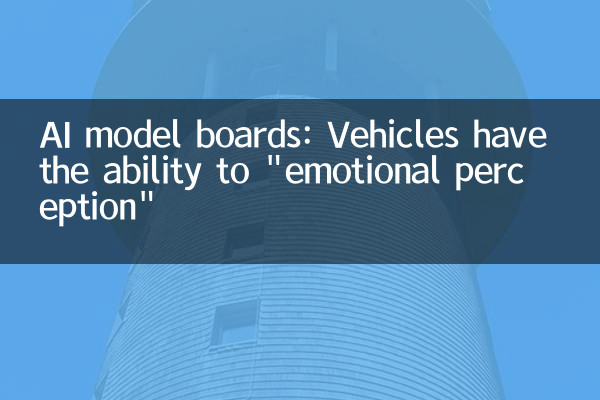AI model boards: Vehicles have the ability to "emotional perception"
In recent years, with the rapid development of artificial intelligence technology, AI models have gradually penetrated into the automotive industry, giving vehicles unprecedented "emotional perception" capabilities. This technological breakthrough not only improves the driving experience, but also brings new possibilities to intelligent transportation systems. The following is a structured analysis of popular topics and hot content on "AI big model to get on the car" across the network in the past 10 days.
1. Overview of popular topics

| topic | Popularity index | Main discussion platform |
|---|---|---|
| Application of AI models in automobiles | 95 | Weibo, Zhihu, TechCrunch |
| Principles of emotion perception technology | 88 | WeChat official account, B station, LinkedIn |
| Cooperation between car companies and technology companies | 85 | 36Kr, Huxiu, Wall Street Journal |
| User feedback on emotional perception functions | 78 | Xiaohongshu, Douyin, Autohome |
2. How to achieve emotional perception in AI big models?
The AI model uses multimodal perception technology, combined with cameras, microphones, biosensors and other devices to analyze the driver's emotional state in real time. For example, the system can identify the driver's fatigue level through facial expressions, or judge his emotional fluctuations through voice tone. Here are the core functions of emotion perception technology:
| Function | Technology implementation | Application scenarios |
|---|---|---|
| Emotion recognition | Facial expression analysis, speech emotion analysis | Automatically play soothing music or adjust the interior ambient lights |
| Fatigue detection | Eye tracking, head posture analysis | Trigger an alarm or suggest a rest |
| Personalized interaction | Natural language processing, historical behavior learning | Recommended routes or services based on emotions |
3. Cooperation trends between car companies and technology companies
Within the past 10 days, many car companies have announced cooperation with technology giants to promote the implementation of AI models in the automotive field. The following are some cooperation cases:
| Car companies | Technology companies | Cooperation content |
|---|---|---|
| Tesla | OpenAI | Integrate GPT-4 to optimize vehicle voice assistant |
| NIO | Baidu | Joint development of emotion perception algorithm |
| BMW | Microsoft | Azure Cloud supports sentiment data analytics |
4. User feedback and disputes
Although emotion perception technology has attracted much attention, users have differences over its actual effects and privacy issues. Here are representative views on social media:
| Type of opinion | Percentage | Typical comments |
|---|---|---|
| Active support | 65% | "The car can understand my emotions, it's so cool!" |
| Privacy concerns | 25% | "Don't want to be monitored by the car" |
| Technical doubt | 10% | “Is the recognition accuracy really high enough?” |
5. Future Outlook
The AI model gives cars emotional perception capabilities, marking a new stage of human-vehicle interaction. In the future, with the maturity of technology and the cultivation of user habits, emotional perception may become the standard function of smart cars. However, how to balance technological innovation with privacy protection is still a key issue that the industry needs to solve.
From technological research and development to commercialization, the application of AI models in the automotive field has just begun. Whether it is a car company or a technology company, it is necessary to focus on user needs and continuously optimize the accuracy and practicality of emotional perception to bring a safer and more considerate travel experience to drivers.

check the details

check the details